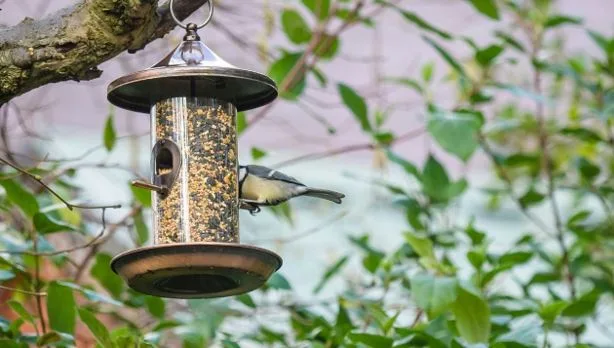How to Choose the Right Bird Feeder for Your Backyard (And What Most People Get Wrong)
Thinking of setting up a bird feeder? Great choice — backyard birdwatching is one of the most relaxing, rewarding hobbies out there. But if you assume all feeders are the same, you’re not alone… and you’re likely in for a frustrating start.
Choosing the wrong type of bird feeder can lead to wasted seed, unwanted pests, and a lot of empty mornings with no birds in sight. That’s because different species prefer different feeding styles, heights, and foods — and some feeder designs just work better than others.
In this guide, we’ll break down the main types of bird feeders, how to match them to the birds you want to attract, and the common beginner mistakes that scare birds away (or invite squirrels in).
The 5 Main Types of Bird Feeders (And Which Birds They Attract)
Not all bird feeders serve the same purpose — and the one you choose will directly affect which birds show up (and which ones avoid your yard entirely). Here’s a breakdown of the five most common feeder types and who they’re best suited for:
1. Tube Feeders
- Best for: Finches, chickadees, nuthatches, titmice
- Details: Long vertical tubes with multiple ports
- Use: Fill with black oil sunflower or nyjer seed
- Bonus: Great for small perching birds, less accessible to squirrels if properly mounted
2. Hopper Feeders
- Best for: Cardinals, grosbeaks, sparrows, doves
- Details: House-shaped with a seed reservoir that dispenses gradually
- Use: Versatile for many seed types
- Bonus: Attracts larger birds but also more vulnerable to squirrels
3. Platform (Tray) Feeders
- Best for: Jays, mourning doves, and ground feeders
- Details: Open tray design that allows any bird to land and feed
- Use: Great visibility, but offers no squirrel protection or weather shielding
- Bonus: Excellent for bird photography
4. Suet Feeders
- Best for: Woodpeckers, wrens, nuthatches
- Details: Wire cages that hold suet cakes
- Use: Especially useful in winter for high-fat energy
- Bonus: Easy to hang from trees or hooks
5. Window Feeders
- Best for: Finches, chickadees, and curious birdwatchers
- Details: Small clear plastic feeders that suction to windows
- Use: Ideal for small spaces or up-close viewing
- Bonus: Surprisingly effective, but needs frequent cleaning
Each of these feeder types can play a role in your setup — and combining two or more is often the best way to attract a wider variety of birds.
Matching the Feeder to the Birds You Want to Attract
The key to choosing the right bird feeder is knowing which birds are common in your area — and which ones you want to invite into your backyard. Each species has unique preferences when it comes to feeder type, food, and placement.
For example, chickadees and titmice prefer tube feeders filled with black oil sunflower seeds, while cardinals are more comfortable feeding from hopper or platform feeders with sunflower or safflower seed. Goldfinches are drawn to narrow-port tube feeders filled with nyjer (thistle), and woodpeckers go straight for suet cakes in wire suet feeders.
If you’re seeing larger birds like blue jays or doves, they’re more likely to visit a wide, open platform feeder — especially if it’s stocked with peanuts, cracked corn, or millet. Meanwhile, birds like nuthatches and wrens love both suet and sunflower seeds and are flexible when it comes to feeder type.
Not sure which birds are in your region? Try using a free birding app like Merlin or browse local bird checklists through the Cornell Lab of Ornithology. Once you understand who your likely visitors are, you can pick a feeder that makes them feel right at home.
Feeder Placement Tips for Visibility, Safety & Success
Even the best bird feeder won’t work if it’s placed in the wrong spot. Birds are cautious by nature — they want access to food, but not at the expense of safety. Proper placement can mean the difference between a busy, active feeder and one that’s completely ignored.
Here are some placement tips to get it right:
- Keep it near natural cover
Place feeders 5–10 feet from shrubs, trees, or bushes. Birds like to perch nearby before approaching, and it gives them a quick escape route if predators show up. - Avoid placing feeders too close to windows
While window feeders are an exception, most feeders should be at least 10 feet away from large glass surfaces to reduce the risk of bird collisions. - Mount at the right height
Small birds prefer feeders around 5–6 feet off the ground. Ground feeders should sit just above the soil, while suet feeders for woodpeckers can be hung higher. - Protect from wind and harsh weather
Choose a spot with some shelter from the elements — too much wind can spill seed or make birds feel unsafe. - Watch for squirrels
Avoid hanging feeders from trees unless they’re specifically squirrel-proof. Squirrels can jump over 10 feet horizontally — keep feeders isolated if possible.
Lastly, make sure the feeder is easy for you to access, too. If it’s a hassle to refill or clean, you’ll be less likely to maintain it — and birds will notice when the seed gets stale or the feeder gets dirty.
What Most People Get Wrong (And How to Avoid It)
If you’ve ever set up a bird feeder and felt disappointed by the lack of activity, you’re not alone. Many new birdwatchers make the same mistakes — but the good news is, they’re easy to fix once you know what to look for.
Mistake #1: Choosing the wrong feeder type
Not all birds use the same feeders. Using a single design (like a basic tube feeder) limits the variety of species you’ll attract. Match your feeder to the birds in your area for better results.
Mistake #2: Using cheap or stale seed
Big-box seed blends often contain filler grains that birds don’t eat, like milo or red millet. These get tossed aside, fall to the ground, and attract pests. Use fresh, high-quality seed like black oil sunflower or safflower.
Mistake #3: Placing the feeder in an unsafe location
Birds want to feel secure. If your feeder is in the open without nearby cover — or too close to windows, heavy foot traffic, or predator zones — they’ll avoid it.
Mistake #4: Ignoring squirrels
Nothing clears out a feeder like an aggressive squirrel. Once they take over, birds stop coming. If squirrels are a constant problem, it’s worth investing in a squirrel-proof model.
Mistake #5: Not cleaning the feeder
Moldy seed, bacteria buildup, and dirty surfaces can make birds sick. Clean your feeder at least once every two weeks — more often in wet weather.
By avoiding these mistakes, you set yourself (and your feathered visitors) up for a far more rewarding backyard birdwatching experience.
Squirrel-Proofing Considerations (Optional but Highly Recommended)
You might think squirrel-proofing is only necessary if you’ve seen squirrels on your feeder — but in reality, they’re often the invisible culprit behind seed waste, feeder damage, and disappearing birds.
Squirrels are strong, persistent, and acrobatic. They can empty a feeder in hours and scare off smaller birds simply by being there. Even if they’re not eating all the seed, their constant presence makes your feeder less attractive to shy species.
Here are a few squirrel-proofing tips that can save your sanity:
- Use a weight-sensitive feeder – These feeders close seed ports when anything heavier than a bird lands on them.
- Add a pole baffle – A metal cone-shaped guard blocks squirrels from climbing up poles.
- Mount feeders strategically – Place feeders at least 6 feet off the ground and 10 feet away from trees, roofs, or fences.
- Choose safflower seed – Many squirrels dislike the bitter taste, while cardinals and other birds still love it.
If you’re ready to skip the trial-and-error phase and want a feeder that solves this issue from day one, check out this guide to the best squirrel-proof bird feeders — all reviewed for durability, effectiveness, and bird friendliness.
A squirrel-proof setup means less waste, less stress, and a more consistent birdwatching experience.
Get the Right Feeder, Get More Birds
Birdwatching should be simple — hang a feeder, add some seed, and enjoy the show. But without the right setup, it can quickly turn into a disappointing (and expensive) guessing game.
The truth is, most feeder frustrations come from small mismatches: the wrong style, the wrong placement, or a feeder that’s more squirrel-friendly than bird-friendly. When you take the time to choose the right feeder for your space and local species — and set it up for safety, visibility, and comfort — the results speak for themselves.
Whether you’re just getting started or looking to upgrade, a little planning goes a long way. And if you’re tired of seed theft and feeder battles, investing in a feeder designed to keep pests out is one of the smartest moves you can make.
With the right gear and a little patience, your backyard can become a birdwatching paradise — one that keeps you (and your feathered guests) coming back every day.






